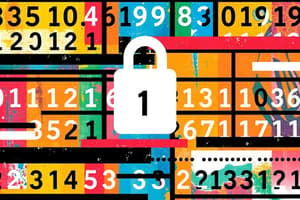Podcast
Questions and Answers
What is the primary purpose of a digital signature?
What is the primary purpose of a digital signature?
- To compress the message for efficient transmission
- To ensure confidentiality of the message
- To verify the integrity and authenticity of the message (correct)
- To encrypt the message content
In the process of generating a digital signature, what is the first step performed by the sender?
In the process of generating a digital signature, what is the first step performed by the sender?
- Generate a hash of the message (correct)
- Encrypt the message with their private key
- Append the sender's public key to the message
- Request a digital certificate from a Certificate Authority
What is the purpose of sending the digital signature along with the message?
What is the purpose of sending the digital signature along with the message?
- To encrypt the message for confidentiality
- To compress the message for efficient transmission
- To request a digital certificate from the recipient
- To enable the recipient to verify the integrity and authenticity of the message (correct)
What is the role of a Certificate Authority (CA) in the context of digital signatures?
What is the role of a Certificate Authority (CA) in the context of digital signatures?
What information is typically included in a digital certificate issued by a Certificate Authority?
What information is typically included in a digital certificate issued by a Certificate Authority?
What is the purpose of non-repudiation in the context of digital signatures?
What is the purpose of non-repudiation in the context of digital signatures?
How is the digital signature typically transmitted along with the message?
How is the digital signature typically transmitted along with the message?
What is the purpose of encrypting the message hash with the sender's private key when generating a digital signature?
What is the purpose of encrypting the message hash with the sender's private key when generating a digital signature?
What is the primary advantage of using digital certificates issued by a trusted Certificate Authority?
What is the primary advantage of using digital certificates issued by a trusted Certificate Authority?
Which of the following statements about digital signatures is incorrect?
Which of the following statements about digital signatures is incorrect?
Flashcards are hidden until you start studying
Study Notes
Introduction to Cryptography
- Cryptography is a chief security measure that allows us to make use of technologies.
- It is an integral part of computing, networking, and daily transactions.
- Cryptography includes encryption, decryption, cryptanalysis, and cryptology.
Encryption and Decryption
- Encryption: transforming plaintext (unencrypted data) into ciphertext (encrypted data).
- Decryption: recovering plaintext from ciphertext.
- Encryption process: plaintext → encryption → ciphertext → decryption → plaintext.
Goals of Cryptography
- Confidentiality: information is only accessible to authorized people.
- Authenticity: confirming the correctness of the claimed identity.
- Integrity: information should only be modified by authorized people.
- Non-Repudiation: a user cannot deny sending a message.
Symmetric Cryptography
- Private key encryption: same key is used for encryption and decryption.
- Key exchange is a challenge in symmetric cryptography.
- Examples of symmetric key algorithms: DES, 3DES, AES.
Asymmetric Cryptography
- Public key encryption: two different keys are used (one for encryption and one for decryption).
- Public key is known to everyone, while private key is only known to the recipient.
- Examples of asymmetric key algorithms: RSA.
Hash Functions
- Keyless cryptography: creates a fixed-length hash value from a message.
- Any slight change to the message will change the hash.
- Hash functions are used for message integrity and digital signatures.
Digital Signatures
- Digital signatures use hash functions to ensure message integrity and authenticity.
- Process: generate a hash of the message, encrypt the hash with a private key, and send the digital signature with the message.
Certificates
- Digital certificates link a public key to a particular individual.
- Certificates are used as a form of electronic identification.
- Created by signing a public key and identifying information with a Certificate Authority (CA).
Studying That Suits You
Use AI to generate personalized quizzes and flashcards to suit your learning preferences.




